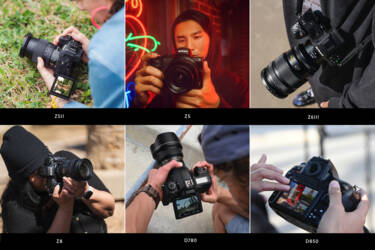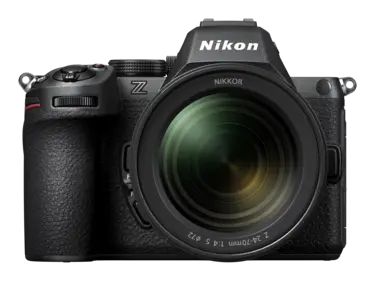The Nikon Z5II compared to the Z5, Z6III, Z8, D780 and D850

How does Nikon’s new ‘entry-level’ camera stack up against its predecessor, bigger mirrorless brothers and two classic DSLRs?
Nikon’s latest mirrorless camera, the Z5II, takes the idea of ‘entry-level’ full frame to new heights. With its blisteringly fast Expeed 7 processor, it has a host of technological advances inherited from the flagship Nikon Z9. But how does it stack up against a few of the Nikon alternatives?
Perhaps you already own a Nikon DSLR and are thinking of moving to mirrorless? Maybe you currently have a high-end camera and are looking for a back-up, secondary body? In this article we’re going to look at the Nikon Z5II and compare it to the original Z5, bigger brothers the mirrorless Z6III and Z8, plus the D780 and D850 DSLRs, to see the differences between them – and the similarities they share.
What’s in our kitbag?

The Nikon D780
Sensors
The Nikon Z5II has a 24.5MP CMOS sensor for fantastic, detailed image quality. The sensor in the Z6III has the same pixel count but is partially stacked, which means faster scan and readout speeds. The DSLR D750 and mirrorless Z5 also have a 24MP sensor, while the Z8 and the D850 both have a 45.7MP sensor that some pros need for greater resolution.
Processors
The Z5II has the same Expeed 7 as the Z6III and the Z8 (as well as the Nikon Z50II, Zf and the flagship Z9). The Expeed 7 gives incredibly fast and efficient performance across all these cameras, ensuring Autofocus is quick and correct (without the need for a dedicated AF engine), enabling better subject tracking, allowing higher ISO with less noise and opening up more capabilities, such as higher burst rates and increased video recording options. The D850 contains the Expeed 5 processor, while the D780 and Z5 are run by an Expeed 6. For context, the Expeed 7 has ten times the image processing speed of its predecessor, the Expeed 6.

The Nikon D850
Burst speeds
For capturing the exact moment, a good burst speed is essential. With the Z5II, you can shoot bursts of up to 30fps in JPEG, 14fps in RAW and 11fps in 14-bit RAW, all of which are much faster than the Nikon Z5, which can shoot up to 4.5fps in JPEG and RAW. The Z6III and Z8, as pro cameras, can shoot up to 120fps JPEG and 20fps RAW in electronic shutter mode. The D850 has a burst speed of 8fps, while the D780 tops out at 7fps or 12fps in Live View mode.
Video capabilities
The Nikon Z5II is great when it comes to creating video. It’s the first Nikon Z camera to record N-RAW footage direct to an SD memory card, shoots 4K/30p full frame, 4K/60p cropped, and can deliver buttery smooth slow motion at 120p in Full HD. The camera also allows you to record in N-Log for professional colour grading. By contrast, the Z5 shoots 4K/30p and Full HD/60p. The Z6III and Z8 are wonderful video cameras, with the Z6III capable of up to 6K/60p and the Z8 8K/60p. Meanwhile, the D850 and D780 can record up to 4K/30p.

The Nikon Z5
Vibration Reduction (VR)
As DSLRs, neither the Nikon D780 nor the D850 have in-body stabilisation, relying instead on VR-equipped NIKKOR lenses. The mirrorless cameras, however, all have VR inside. The Nikon Z5II offers up to 7.5 stops of Vibration Reduction across the frame at the centre of the image and 6 stops at the edges. It also includes Focus Point VR (also a feature of the Z6III), which allows you to centre the full 7.5 stops of vibration reduction on your subject anywhere in the frame. The Z6III offers up to 8 stops of VR while the Z8 has up to 5.5 stops and the original Z5 has 5 stops.
Mount
The Nikon Z5II has the same Z mount as all Nikon mirrorless cameras, whereas the D780 and D850 are F mount. The Z mount is the widest of any mirrorless system, allowing more light to the sensor and the creation of newly designed and superior lenses. Using the FTZII adapter, you can attach older F mount lenses to a Nikon Z camera. The reverse, however, isn’t possible and Z mount lenses cannot be attached to older F mount cameras.
The Nikon Z5II
Autofocus
With 273 focus points in single-point AF and 299 in auto-area AF, the Expeed 7-powered autofocus on the Nikon Z5II is the same as that on the Z6III. That’s compared to the 273 focus points on the Z5, 153 focus points on the older Nikon D850 and 51 focus points on the D780. At the other end of the scale, the pro-level Nikon Z8 has 493 focus points. In terms of subject detection, the Z5II can detect nine types of subject (people, cats, dogs, birds, cars, trains, planes, bicycles and motorbikes), which is the same as the pro-level Z8. The Z6III has detection settings for people, animals, cars, motorbikes, bicycles, trains and planes, while the Z5 offers detection of face/eye, face and animals. As for the DLSRs, they both detect faces but not other subjects.
Viewfinders
The electronic viewfinder (EVF) in a mirrorless camera can offer many benefits over the older optical viewfinders found on the D780 and D850. They give increased flexibility, accuracy with manual focus (especially for macro work), easier working in challenging light conditions and the ability to see the effects of exposure settings as you compose and shoot. The EVF in the Nikon Z5II reaches a maximum of 3000 nits brightness – three times brighter than the original Z5. It also has a resolution of 3.69m dots and a 60fps refresh rate for smooth motion tracking. The Z8 has the same resolution but a 120fps refresh rate, while the Z6III’s EVF is the brightest of all, with a resolution of 5.67m dots with a maximum brightness of 4000 nits and a 120fps refresh rate.

The Nikon Z6III
Monitors
The Nikon Z5II and Z6III share the same vari-angle 3.2-inch 2100k-dot monitor with 15 levels of adjustable brightness and a 170-degree viewing angle so, however you shoot, you can see what’s going on. The same monitor is on the Nikon Z8 but instead of vari-angle it is vertically and horizontally tilting. This is a significant upgrade on the Z5, with its 1040k-dot tilting 3.2-inch monitor. The Nikon D850 and D780 both have a 3.2-inch tilting monitor, with a resolution of 2359k-dot.
Low light performance
With the same ISO range, the Nikon Z6III – 100-64,000 for stills (expandable to 204,800) and 100-51,200 for video – and the Nikon Z5II can perform in the lowest of light, with the Expeed 7 processor reducing noise in the image. With larger sensors, both the Z8 and D850 have a native range of 64-25600 (expandable to 102,400), while the D780 and the original Z5 have a range of 100-51,200.

The Nikon Z8
What’s the conclusion?
All of the above cameras are great pieces of engineering capable of taking amazing images. The latest generation of mirrorless Nikon Z cameras, however, have much more capable and versatile AF than the older DSLRs, enabling you to create fantastic imagery even in the most challenging conditions. For those who want to take more video, models such as the Z5II, Z6III and Z8 offer much more capability, and the addition of subject detection in mirrorless cameras makes it easier and faster get the shot you want when the moment arrives. The D850 is still lauded as possibly the greatest DSLR ever made, but the new mirrorless options can offer the same (or much better) performance, enhanced capabilities of the sharp, bright EVF plus the ability to make use of the optical performance of Nikon Z glass AND all your beloved F mount lenses. For pros who want flagship performance in a smaller body, the Z8 is the obvious choice, but the Z6III offers near flagship performance at a lower price point and in a smaller body. The Nikon Z5II, with its Expeed 7 processor, has everything you need and nothing you don’t. It’s an ‘entry-level’ camera that is anything but and will be used by pros as a second body – it represents a perfect move into full-frame photography and video creation.
More in Gear
Featured products
Discover the Nikon Z5II

Unlock greater creativity








